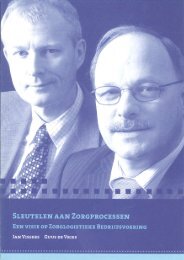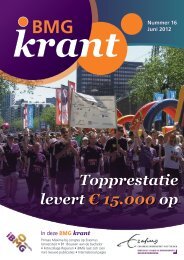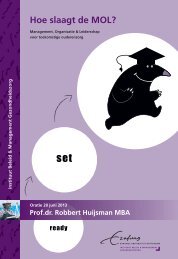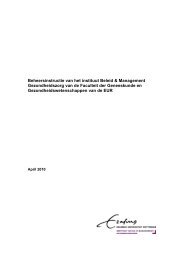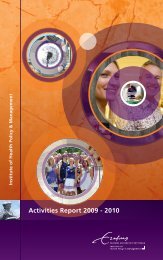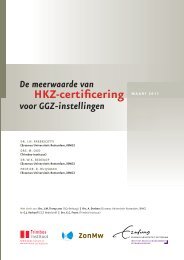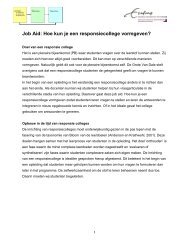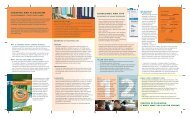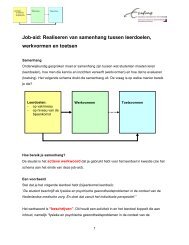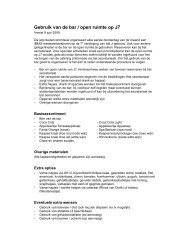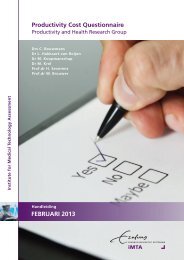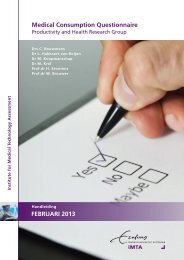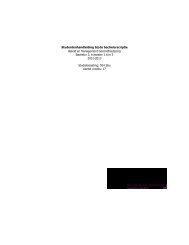78Chapter 5Figure 5.3 illustrates one-year survival rates with ECMO for each birth yearcohort, combined with the annual number of patients treated with ECMO. Withtime elapsing, the number of ECMO patients increased considerably, whereas thesurvival rates improved only slightly (but with decreasing standard deviation ofthe data). As an additional analysis, we finally compared one-year survival ratesof the first 25 and 50 ECMO patients to the results after excluding the first 25 and50 cases. For the first 25 ECMO patients, the survival rate was lower than therate after excluding these 25 patients (0.72 v 0.77; P = 0.57). Similarly,comparing the first 50 patients with the situation of leaving out these patients, nostatistically significant difference in survival was found (0.74 v 0.77; P = 0.62).Cost-effectivenessFrom the above, it follows that for the patients with CDH costs per additionalsurvivor amounted to € 78,455, or € 3,153 per life-year gained. For the patientswith MAS, costs per additional survivor were calculated at € 17,287, or € 697 perlife-year gained.Sensitivity analysesThe main conclusions are quite insensitive to the assumptions regarding thesurvivors' life-expectancy and the discount rate, as appears from the extremescenarios. In the best-case scenario, cost-effectiveness ratios amounted to € 881per life-year gained in CDH and € 195 per life-year gained in MAS. Even in theworst-case scenario, cost-effectiveness (€ 3,858 and € 854 per life-year gained inCDH and MAS respectively) was still good.Figure 5.335Annual Numbers of Patients Treated with ECMO and Annual One-Year SurvivalRates (CDH and MAS Patients Combined)1,0300,90,8250,7Annual number of patients treated with ECMO20151050,60,50,40,30,20,1One-year survival rate with ECMO01991 1992 1993 1994 1995 1996 1997 1998 1999 2000 2001Year of Birth0,0
Cost-Effectiveness of Neonatal Extracorporeal Membrane Oxygenation in the Netherlands 795.4 DISCUSSIONThis paper has focused attention on the cost-effectiveness of neonatal ECMO inthe Netherlands. One of this study's major strengths lies in its inclusion of anational population of 244 consecutive ECMO-treated neonates. Another strengthwas the inclusion of a comparison group that consisted of adequately similar non-ECMO-treated infants, as (even though the outcome predicted by this modeldiffered from the actual outcome of our study in terms of survival or death) canbe concluded from applying the predictive outcome model described byToomasian et al. 39 The study shows that ECMO in severely ill newborns diagnosedwith CDH or MAS is highly cost-effective. The cost-effectiveness ratios are withinthe range reported for other commonly used treatments in the field of neonatalintensive care, 27,45-50 and, generally, compare favorably to other evaluated healthcare interventions that 'society' considers to be acceptable expenditure of scarceresources. 21,51ECMO appeared to be a labor-intensive and costly technique. Still, costs of ECMOtreatment are considerably lower in our study than in the American studies, whichrelied on charges and sometimes used cost-charge ratios to arrive at costs.Pearson and Short reported initial hospitalization costs of $ 91,804, Walsh-Sukyset al. $ 62,375, Metkus et al. $ 208,000 for CDH patients, and Schumacher et al.$ 53,700 in the late ECMO group. 17-20 Cost differences are even more impressivefor conventional treatment, the cost of which ranges from $ 59,268 to $ 93,524 inthe American studies. 17,19,20 These differences are probably for a large part due tothe fact that treatment costs are lower for many medical interventions in theNetherlands than in the USA. 52 More specifically, one possible explanation is theuse of inhaled nitric oxide (iNO), for which high prices have been charged in theUSA and which was available in the USA many years earlier than in theNetherlands. It is difficult to say whether these differences can be explained byvariations in the length of the average hospital stay, because the literaturefrequently does not give an account of these data, with a distinction madebetween the different diagnostic categories. What can be compared is theaverage length of an ECMO run. For the CDH patients in our study, the run timewas practically equal to the figure reported by the Extracorporeal Life SupportOrganization (ELSO) (mean, 229 hours). 53 However, for the infants with MAS, theaverage ECMO duration in this study outweighed that of the patients who appearin the ELSO database (163 v 129 hours). Unlike studies that found an increase inthe average length of an ECMO run since the 1990s, 26,54,55 which probably reflectsa more complex patient case mix, the length of bypass appeared to be stableover time in this study.We found survival probabilities of 52% (CDH) and 94% (MAS). These outcomesare nearly identical to those reported by ELSO. 53 Although not every study hasshown positive effects, especially in CDH patients, 56-58 there is growing evidencethat the introduction of ECMO accounts for enhanced survival rates in selected,
- Page 3:
COST-EFFECTIVENESS OF NEONATAL SURG
- Page 6 and 7:
DOCTORAL COMMITTEEPromotors:Prof.dr
- Page 9 and 10:
PUBLICATIONSChapters 2 to 7 are bas
- Page 11:
6ChapterINFORMAL CARE FOR CHILDREN
- Page 14 and 15:
2Chapter 11.1 BACKGROUND AND MOTIVA
- Page 16 and 17:
4Chapter 1provides a good overview
- Page 18 and 19:
6Chapter 1disability, and death of
- Page 21:
Introduction 9particular equity pri
- Page 25 and 26:
Introduction 1320. Oostenbrink JB,
- Page 27 and 28:
Introduction 1554. Heyman MB, Harma
- Page 29 and 30:
THE COST-EFFECTIVENESS OFTREATMENT
- Page 31:
Cost-Effectiveness of Treatment for
- Page 35 and 36:
Cost-Effectiveness of Treatment for
- Page 37 and 38:
Cost-Effectiveness of Treatment for
- Page 39 and 40: Cost-Effectiveness of Treatment for
- Page 41 and 42: Cost-Effectiveness of Treatment for
- Page 43 and 44: Cost-Effectiveness of Treatment for
- Page 45: Cost-Effectiveness of Treatment for
- Page 48 and 49: 36Chapter 3ABSTRACTBackground/Purpo
- Page 50 and 51: 38Chapter 33.2 MATERIALS AND METHOD
- Page 52 and 53: 40Chapter 3child's date of birth) a
- Page 54 and 55: 42Chapter 3diaphragm was closed (Ta
- Page 56 and 57: 44Chapter 3Total costs of treatment
- Page 58 and 59: 46Chapter 3Regarding the treatment
- Page 60 and 61: 48Chapter 3REFERENCES1. Stolk EA, P
- Page 62 and 63: 50Chapter 332. Jaillard S, Pierrat
- Page 64 and 65: 52Chapter 4ABSTRACTAims:To examine
- Page 66 and 67: 54Chapter 4Outcome measuresThe pati
- Page 68 and 69: 56Chapter 4Clearly, the symptoms st
- Page 70 and 71: 58Chapter 4The respondents did not
- Page 72 and 73: 60Chapter 4Table 4.4TAIQOL Scores o
- Page 74 and 75: 62Chapter 44.4 DISCUSSIONIn this pa
- Page 76 and 77: 64Chapter 4ACKNOWLEDGMENTSWe are in
- Page 78 and 79: 66Chapter 418. Coons SJ, Rao S, Kei
- Page 80 and 81: 68Chapter 5ABSTRACTObjective:Extrac
- Page 82 and 83: 70Chapter 5treatment. 26,27 Finally
- Page 84 and 85: 72Chapter 5CostsOnly direct costs w
- Page 86 and 87: 74Chapter 5summarized in Table 5.2.
- Page 88 and 89: 76Chapter 5Table 5.3 Direct Medical
- Page 92 and 93: 80Chapter 5severely ill newborns—
- Page 94 and 95: 82Chapter 5REFERENCES1. Bartlett RH
- Page 96 and 97: 84Chapter 533. Meinert CL: Extracor
- Page 98 and 99: 86Chapter 568. Hui TT, Danielson PD
- Page 100 and 101: 88Chapter 6ABSTRACTObjective:To inv
- Page 102 and 103: 90Chapter 6a rule. The health-relat
- Page 104 and 105: 92Chapter 6Regression analysis of h
- Page 106 and 107: 94Chapter 6that caregiving for thei
- Page 108 and 109: 96Chapter 6Table 6.5 CareQol Compar
- Page 110 and 111: 98Chapter 6children with a disabili
- Page 112 and 113: 100Chapter 6This study was of impor
- Page 114 and 115: 102Chapter 618. Poley MJ, Stolk EA,
- Page 116 and 117: 104Chapter 654. Boman KK, Viksten J
- Page 118 and 119: 106Chapter 7ABSTRACTMortality rates
- Page 120 and 121: 108Chapter 77.2 THE RELEVANCE OF CO
- Page 122 and 123: 110Chapter 7In the early 2000s, our
- Page 124 and 125: 112Chapter 7Table 7.1 Economic Eval
- Page 126 and 127: 114Chapter 7More from a policy pers
- Page 128 and 129: 116Chapter 7also expect that life-s
- Page 130 and 131: 118Chapter 7entirely justified, for
- Page 132 and 133: 120Chapter 723. Sydorak RM, Nijagal
- Page 134 and 135: 122Chapter 765. Glaser AW, Davies K
- Page 137 and 138: GENERAL DISCUSSION:A GUIDED TOURPRO
- Page 139 and 140: General Discussion: A Guided Tour P
- Page 141 and 142:
General Discussion: A Guided Tour P
- Page 143 and 144:
General Discussion: A Guided Tour P
- Page 145 and 146:
General Discussion: A Guided Tour P
- Page 147 and 148:
General Discussion: A Guided Tour P
- Page 149 and 150:
General Discussion: A Guided Tour P
- Page 151:
General Discussion: A Guided Tour P
- Page 154 and 155:
142GlossaryCharge (or: tariff)A pri
- Page 156 and 157:
144Glossaryefficient one. We are th
- Page 159 and 160:
SUMMARY
- Page 161 and 162:
Summary 149mortality. Finally, it i
- Page 163 and 164:
Summary 151neonatal surgery. It is
- Page 165 and 166:
SAMENVATTING
- Page 167 and 168:
Samenvatting 155zoals directe niet-
- Page 169 and 170:
Samenvatting 157Hoofdstuk 6 gaat ve
- Page 171:
Samenvatting 159vereisen, waarvoor
- Page 174 and 175:
162AcknowledgmentsAlthough I am ind
- Page 176:
About the AuthorBorn in De Meern (N




